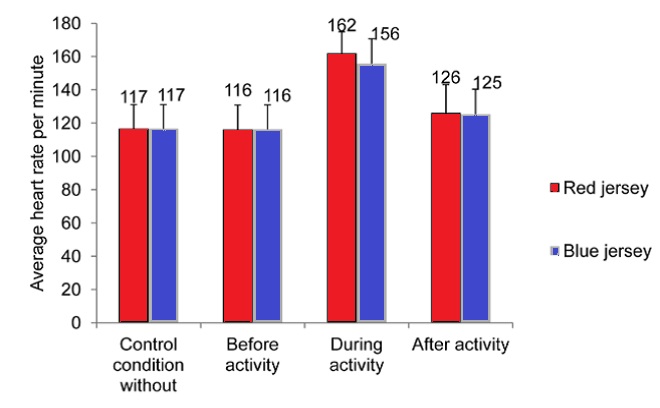Research
Red Enhances Human Performance in Contests
When all factors are equal, red tips the balance.
In the 2004 Athens Olympics, contestants in four combat sports (Boxing, Taekwondo, Greco-Roman wrestling, and Freestyle wrestling) were randomly assigned red or blue outfits.
In all four competitions, contestants wearing red won more fights. This was found to be consistent across rounds and weight classes for each sport. When there was a degree of asymmetry – a difference in skill level – between the competitors, the red advantage declines.


The red advantage can also be seen in team sports. In the Euro 2004 soccer tournament, five teams wore both a predominantly red shirt and a shirt of a different colour over the course of the competition. All five teams had significantly better results in their red shirts.
This fact remained true even after controlling for differences in the quality of opposition that teams faced while wearing the two different shirt colours.
Although many factors influence sporting outcomes, the most successful teams in English league football over the last few decades (Liverpool, Manchester United, and Arsenal) have all worn red.
An analysis of the English Football League, drawing on archive data (English Football Archive, 2006; Rivals Digital Media Ltd., 2006), from 1946-47 to 2001 and 2003 – while controlling for various biases (e.g. access to more resources) – the proportion of league champions since 1947 corroborate the above: teams with red shirts winning substantially more often than expected on the basis of frequency.

Wearing red increases heart rate and strength
Pairs of male athletes were matched for weight, height, and age and participated in a combative sporting event, once in a red jersey and once in blue. The heart rate and strength were measured before, during, and after a combative sport event. The study found that male participant athletes in red had a higher heart rate and greater strength before the fight than those in blue.
Judges’ Bias towards Red
In a study examining basic perception of red versus blue, human judges were asked to address the social signalling properties of red. Male and female judges interpreted shapes in red to be more ‘aggressive’, ‘dominant’, and ‘more likely to win’ than blue.
This confirms that the colour red is special in social attribution consistent with it being a signal of competitive quality.
Male and female judges perceive red to be more aggressive, dominant, threatening, and more likely to win.
In this study, experienced Taekwondo judges scored the outcome of bouts – according to the rules of the World Taekwondo Federation) recorded on video. The first graph shows the red advantage in the scoring of the original videos. When the colours were digitally reversed and the same clips were shown in a different order. The second graph shows that the colour change caused a change in the judges’ scores. The judges assigned more points to the athlete in red than blue (watch here). The same effect has now also been demonstrated in both European and Chinese judges.
Redness Enhances Perceived Aggression, Dominance and Attractiveness in Men’s Faces
Female participants were asked to manipulate a CIELab a* (red-green axis) of skin to maximize the perceived aggression, dominance and attractiveness of photographs of men’s faces.
The highest level of red was associated with aggression, an intermediate level with dominance, and the least level of red was associated with attractiveness.
Red Clothing Increases Perception of Dominance, Aggression, and Anger
Participants were asked to rate aggression, dominance, and categorize the emotional state of digitally manipulated photos of shirt colour (blue, grey, and red). Men wearing red were rated as more aggressive, more dominant, and angry than men wearing grey or blue. There was no difference between blue and grey.
No effects with blue and white
After controlling for the allocation of biases, asymmetries in prior experience and differences in recovery time as possible confounding factors, a study drawing on data from 71 major Judo tournaments found that there was no winning bias in white-blue outfit pairing:
White and blue outfits can ensure a level playing field.
Summary
- Colour has pervasive effects on human psychology, judges’ perceptions, and competitors physical performance.
- These effects can bias the outcome of combat sports, and compromise the ‘level playing field’ expected by participants and audiences worldwide.
- It is particularly the colour red that causes psychological and behavioural effects, suggesting that other colour combinations present a possible solution.
- Methods of scoring and training judges may help also ameliorate bias, but will not deal with psychological impacts on the competitors themselves.
- Ongoing research at Durham University, and elsewhere, is examining these effects in more detail.
See our brochure here
List of Publications











